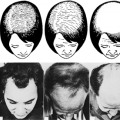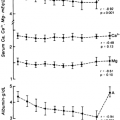ETIOLOGY
Part of “CHAPTER 43 – ENDOCRINE OPHTHALMOPATHY“
Proptosis, soft-tissue involvement, and ophthalmoplegia occurring in a patient with concurrent thyrotoxicosis or a past history of hyperthyroidism suggests dysfunction of the thyroid. Occasionally, Hashimoto thyroiditis, with or without clinical hypothyroidism, may be coexistent. When the eye changes occur in apparently euthyroid patients, not only Graves ophthalmopathy but also other primary orbital diseases must be considered.
Although the fundamental cause of Graves disease is unknown, the hyperthyroidism is generally accepted to be caused by a group of thyroid-stimulating immunoglobulins directed toward thyroid-stimulating hormone (TSH) receptors.13,14,15,16 and 17 Whether or not these same antibodies also are responsible for the ophthalmopathy and associated immune syndromes remains to be determined,18,19 and 20 although B lymphocytes represent a minor fraction of the cells infiltrating orbital connective tissue and muscle. Although no studies have demonstrated in vivo binding of TSH-receptor antibodies to TSH receptor in retroocular tissues, findings of TSH-receptor transcripts and TSH receptor– like proteins in orbital fibroblasts suggest an important link to the pathogenesis,21,22 albeit possibly to only a portion of the TSH receptor.23 Some in vitro evidence of cytotoxic responses against eye muscle antigens exists, but no histologic evidence of cytotoxicity against eye muscle has been demonstrated. A 64-kDa protein has been identified that may be a shared eye muscle and thyroid antigen, but its specificity to Graves ophthalmopathy patients has not been established.
One hypothesis is that autoreactive CD4+ T lymphocytes are activated by thyroid antigen in Graves disease, leading to the immune response against the TSH receptor and T-cell infiltration in the orbit. T lymphocytes are the predominant cells infiltrating eye muscle and are drawn to the eye by a complex interaction involving expression by retroocular fibroblasts of intercellular adhesion molecule-1 along with vascular and endothelial adhesion molecules.24 A variety of other cytokines (interferon-γ, transforming growth factor-β, interleukin-1, tumor necrosis factor, and other fibroblast growth and activating factors) are also involved.25 The cytokines stimulate the fibroblasts to release glycosaminoglycans, which, because of their hydrophilic nature, lead to interstitial edema.26 Progression of the autoimmune response with more intense lymphocyte infiltration, fibroblast proliferation, and edema leads to increased orbital tissue volume, protrusion of the globe, exposure keratopathy, and venous compression, which in turn results in more edema. What initiates the entire process in genetically susceptible people is under intense study. The possible role played by the release of thyroid antigen, such as occurs after radioiodine therapy,27,28,29,30,31 and 32 and by eye muscle as antigen,33 as well as by other exogenous factors, has been reviewed. Superoxide (oxygen free) radicals have been implicated as well, with the proliferative response from orbital fibroblasts being caused by conditions of oxidative stress.34 One such stress may be tobacco smoking, which has been associated with worsening ophthalmopathy.13,14,35,36 and 37
Stay updated, free articles. Join our Telegram channel

Full access? Get Clinical Tree





